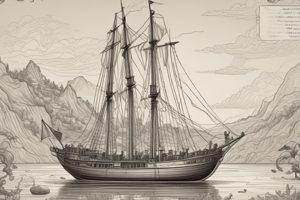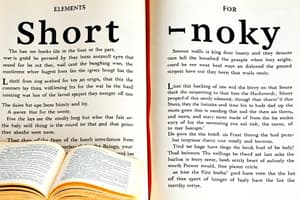Podcast
Questions and Answers
In a story, how do characters and conflict work together to drive the plot forward?
In a story, how do characters and conflict work together to drive the plot forward?
Characters face conflicts which motivate their actions, creating tension and propelling the plot.
Explain the significance of the climax in a narrative structure.
Explain the significance of the climax in a narrative structure.
The climax is the pivotal moment of highest tension where the main conflict reaches its peak, influencing the outcome of the story.
Discuss how the theme of a story can influence the characterization of protagonists and antagonists.
Discuss how the theme of a story can influence the characterization of protagonists and antagonists.
The theme shapes the motivations and moral dilemmas of characters, highlighting their struggles and growth through the narrative.
What role do action verbs play in enhancing the description of a plot's rising action?
What role do action verbs play in enhancing the description of a plot's rising action?
How do the different tenses of verbs shape the reader's perception of a story’s setting and actions?
How do the different tenses of verbs shape the reader's perception of a story’s setting and actions?
Which element of a story primarily reveals the struggles faced by the protagonist?
Which element of a story primarily reveals the struggles faced by the protagonist?
In what part of the plot is the main problem of the story first introduced?
In what part of the plot is the main problem of the story first introduced?
What does the term 'resolution' in a plot signify?
What does the term 'resolution' in a plot signify?
Which type of tense is used to describe actions that have been completed at some point in the past?
Which type of tense is used to describe actions that have been completed at some point in the past?
What type of verbs are described as words that accomplish tasks within a narrative?
What type of verbs are described as words that accomplish tasks within a narrative?
Flashcards are hidden until you start studying
Study Notes
Elements of a Story
- Characters: Individuals or animals playing roles in a story; can be protagonists (main characters) or antagonists (opposing characters).
- Setting: The specific time and place where the narrative occurs.
- Conflict: The primary challenge or issue faced by the protagonist in the story.
- Solution: The action or decision taken by the character to address and resolve the conflict.
- Plot: The sequence of events that occur within the narrative, typically structured in five parts: introduction, rising action, climax, falling action, and resolution.
Parts of Plot
- Beginning Action/Introduction: Establishes initial events, introduces the setting and characters.
- Rising Action: Unveils the main conflict; reveals struggles between protagonist and antagonist.
- Climax: The story's turning point, marked by the most intense or thrilling moments.
- Falling Action: The stage where the conflict begins to resolve.
- Resolution/Ending: The concluding events that wrap up the story.
Theme
- Represents the central idea or moral lesson the author intends to convey to the audience.
Action Verbs
- Defined as words that describe actions; they are crucial for conveying what characters do.
Simple Tenses of Verbs
- Simple Past Tense: Describes actions that occurred in the past.
- Present Tense: Communicates current conditions, facts, general truths, and habitual actions.
- Future Tense: Indicates actions expected to occur in the future.
Elements of a Story
- Characters: Individuals or animals playing roles in a story; can be protagonists (main characters) or antagonists (opposing characters).
- Setting: The specific time and place where the narrative occurs.
- Conflict: The primary challenge or issue faced by the protagonist in the story.
- Solution: The action or decision taken by the character to address and resolve the conflict.
- Plot: The sequence of events that occur within the narrative, typically structured in five parts: introduction, rising action, climax, falling action, and resolution.
Parts of Plot
- Beginning Action/Introduction: Establishes initial events, introduces the setting and characters.
- Rising Action: Unveils the main conflict; reveals struggles between protagonist and antagonist.
- Climax: The story's turning point, marked by the most intense or thrilling moments.
- Falling Action: The stage where the conflict begins to resolve.
- Resolution/Ending: The concluding events that wrap up the story.
Theme
- Represents the central idea or moral lesson the author intends to convey to the audience.
Action Verbs
- Defined as words that describe actions; they are crucial for conveying what characters do.
Simple Tenses of Verbs
- Simple Past Tense: Describes actions that occurred in the past.
- Present Tense: Communicates current conditions, facts, general truths, and habitual actions.
- Future Tense: Indicates actions expected to occur in the future.
Studying That Suits You
Use AI to generate personalized quizzes and flashcards to suit your learning preferences.




